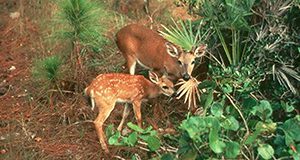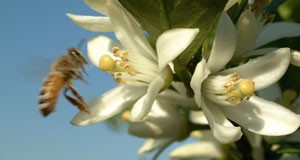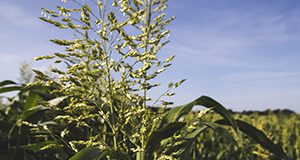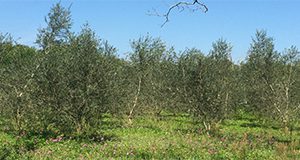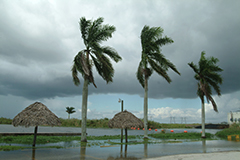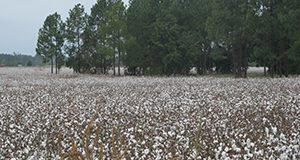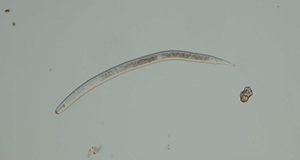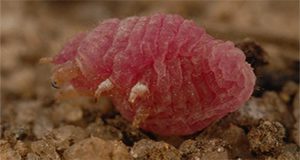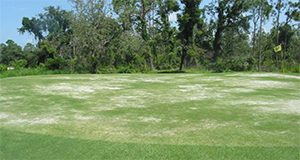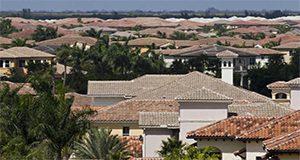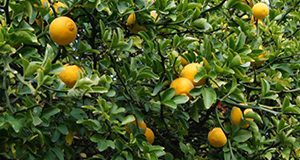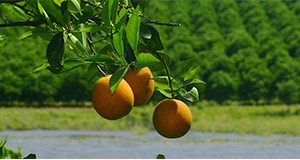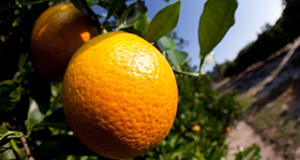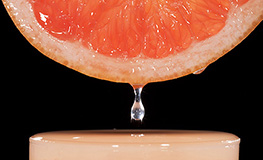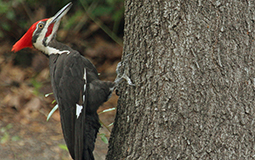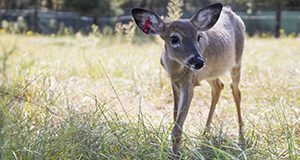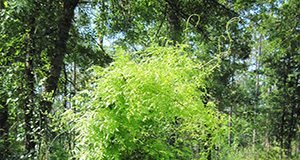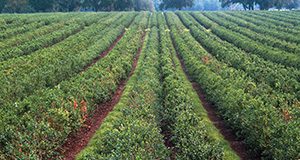Where do the animals go when the sea rises? Learn the probable futures of Florida panthers and other south Florida wildlife in this 5-page fact sheet. Written by Larry Perez, James I. Watling, David Bucklin, Mathieu Basille, Frank J. Mazzotti, Stephanie Romañach, and Laura Brandt and published by the UF Department of Wildlife Ecology and Conservation, it explains how a changing climate could impact wild animals.
edis.ifas.ufl.edu/uw428
Author: Susan Gildersleeve
Does Consumers' Awareness Impact Their Purchase Likelihood of Neonic-Free Plants?
Neonicotinoid (neonic) pesticides have been facing intense scrutiny because of their potential role in pollinator insect population declines. Research has shown that insecticide use in general has resulted in $284 million per year in damages to honeybee and pollinator services in the United States. This is especially worrying because food supply would fail to meet increasing global food demand without pollinator insects.
Consumer awareness of neonic pesticides increases the purchase likelihood for plants that are labeled “neonic-free,” and, as consumer awareness of neonics increases, demand for plants may decrease if there is limited availability of neonic-free options. This 5-page fact sheet written by Hayk Khachatryan and Alicia Rihn and published by the Food and Resource Economics Department explains the practical implications for growers, retailers, and policy makers and describes how these stakeholders can benefit from increased awareness of this important new market niche.
edis.ifas.ufl.edu/fe1008
Management of Plant-Parasitic Nematodes in Florida Field Corn Production
This 8-page fact sheet written by Zane J. Grabau and Christopher Vann and published by the Department of Entomology and Nematology explains how corn producers can spot nematode symptoms, sample for nematodes, and manage nematode problems.
http://edis.ifas.ufl.edu/ng014
Xylella fastidiosa and Olive Quick Decline: Symptoms and Identification of an Insect Vectored Pathogen
A plant disease called Olive Quick Decline is killing olive trees throughout southern Italy. Although the pathogen that causes the disease is not known in Florida, it may spread to the state, which means that olive producers and homeowners with olives must watch for symptoms of the disease as well as for the leafhopper insects that spread it. This 3-page fact sheet written by Whitney Elmore and Jennifer L. Gillett-Kaufman and published by the Department of Entomology and Nematology explains how to monitor for the disease and its insect vectors and offers advice and assistance for commercial and hobby olive growers.
http://edis.ifas.ufl.edu/in1165
Strategies for Communicating Climate Change to Extension Audiences
Second in a series on climate change communication for Extension professionals, this 5-page fact sheet written by Claire Needham Bode, Martha C. Monroe, and Mark Megalos and published in January 2017 by the UF School of Forest Resources and Conservation provides strategies for overcoming challenges in communicating about climate change.
http://edis.ifas.ufl.edu/fr402
Management of Plant-Parasitic Nematodes in Florida Cotton Production
This 8-page fact sheet written by Zane J. Grabau and published in January 2017 by the UF Department of Entomology and Nematology explains how to diagnose and manage nematode problems in cotton production.
http://edis.ifas.ufl.edu/ng015
Management of Plant-Parasitic Nematodes in Florida Soybean Production
This 8-page fact sheet written by Zane J. Grabau and published by the UF Department of Entomology and Nematology in January 2017 explains how to identify and manage a nematode issue in a soybean operation.
http://edis.ifas.ufl.edu/ng018
Managing Scale Insects and Mealybugs on Turfgrass
This 8-page fact sheet written by Adam Dale and published by the UF Department of Entomology and Nematology in February 2017 describes the types of scale insects and mealybugs that can become pests in turf, explains the damage they do, and lists management techniques to control them.
http://edis.ifas.ufl.edu/in1166
Nematode Management for Golf Courses in Florida
UF/IFAS is committed to providing the most current information on the notoriously difficult problem of managing nematodes on golf courses. This publication is updated and revised whenever there is a breaking development, to bring you the new information and management advice. Nine pages, revised in January 2017 by William T. Crow and published by the UF Department of Entomology and Nematology.
http://edis.ifas.ufl.edu/in124
Estimating Benefits of Residential Outdoor Water Conservation: A Step-by-Step Guide
This 9-page fact sheet written by Tatiana Borisova, Laura A. Warner, Jennison Searcy, Anil Kumar Chaudhary, and Michael Dukes and published by the UF Department of Food and Resource Economics in February 2017 was developed to help Extension agents, water-conservation managers, and homeowners estimate the economic benefits of residential outdoor water conservation. It provides guidance for reporting benefits, including lowered utility bills for homeowners, reduced water-delivery costs for utilities, and increased water supply. This publication also offers an example of an impact statement.
http://edis.ifas.ufl.edu/fe1009
Evolution of Citrus Disease Management Programs and Their Economic Implications: The Case of Florida’s Citrus Industry
New exotic diseases (citrus canker, HLB, and citrus black spot) have sharply increased the real cost of production of citrus in Florida. Growers have been applying different management strategies, and more effective treatments are being researched. The costs and benefits of these alternatives will need to be quantified to establish their economic feasibility. This 5-page fact sheet written by Ariel Singerman and Marina Burani-Arouca and published by the Food and Resource Economics Department focuses on the costs of managing exotic citrus diseases as they become endemic or established within a citrus industry, with Florida used as an example. The steep increase in the real cost of production of citrus in Florida from 2003/04 to 2014/15 provides evidence that managing endemic exotic diseases is very costly for growers, even without taking into account the effect those diseases have on yields. Therefore, governmental policies focused on preventing the introduction of additional exotic diseases would be highly beneficial for citrus growers and the Florida citrus industry as a whole.
edis.ifas.ufl.edu/fe915
Cost of Production for Processed Oranges Grown in Southwest Florida, 2015/16
This 4-page fact sheet written by Ariel Singerman and published by the Department of Food and Resource Economics presents the cost of production per acre for processed oranges in southwest Florida during 2015/16. Thirteen growers participated in the survey and provided annual, per-acre costs by program for a “typical” irrigated, mature grove (10+ years old), including resets. The number of acres managed by their combined operations accounts for approximately 41,000 acres, of an estimated 257,298 acres devoted to oranges in the area, so the sample represents 16% of the acreage devoted to oranges in that region. Typical users of the estimates in this publication include growers, consultants, property appraisers, and researchers.
http://edis.ifas.ufl.edu/fe1007
Cost of Production for Processed Oranges Grown in Central Florida (Ridge), 2015/16
This 4-page fact sheet written by Ariel Singerman and published by the Department of Food and Resource Economics presents the cost of production per acre for processed oranges in central Florida during 2015/16. Five growers participated in the survey and provided annual, per-acre costs by program for a “typical” irrigated, mature grove (10+ years old), including resets. The number of acres managed by their combined operations accounts for approximately 29,000 acres, of an estimated 137,154 acres devoted to oranges in the area, so the sample represents 21% of the acreage devoted to oranges in that region. Typical users of the estimates in this publication include growers, consultants, property appraisers, and researchers.
http://edis.ifas.ufl.edu/fe1006
An Overview of the Grapefruit Market in South Korea
According to the Foreign Agricultural Service of the United States Department of Agriculture, worldwide consumption of fresh grapefruit in 2014/15 increased from 4.2 million to 5.2 million metric tons. China, which is the largest producer of grapefruit, was largely responsible for the increase. In South Korea, however, the state of Florida in the United States has traditionally dominated the grapefruit market. The South Korean grapefruit market has been increasing in recent years and is expected to keep growing. The industry in Florida now faces fierce competition from other suppliers with lower import prices and different harvest seasons. This 5-page fact sheet written by Yan Heng, Hyeyoung Kim, and Lisa House and published by the Food and Resource Economics Department aims to provide an overview of the grapefruit market in South Korea and evaluate the potential of this market for Florida fresh grapefruit producers.
http://edis.ifas.ufl.edu/fe1003
Building for Birds Evaluation Tool: Breeding and Wintering Habitat for Forest Birds
Several bird species use forest fragments and trees conserved in built areas as breeding, wintering, and stopover habitat. Scientists have created a Building for Birds online tool to help these birds and the people who appreciate them. This evaluation tool is most useful for small developments or developments in already fragmented landscapes.
The tool is designed for use when no opportunity is available to conserve large forest areas of 125 acres or more within a proposed development. Developers are sometimes reluctant to conserve trees and forest fragments in subdivided residential/commercial areas because it costs time and money, but there is value in this conservation effort not only for many different species of forest birds, but for future homeowners waking to birdsong in the mornings.
This 17-page fact sheet written by Mark Hostetler and Jan-Michael Archer and published by the Department of Wildlife Ecology and Conservation describes the online tool and shows how it can help preserve breeding and wintering habitat for migrating birds.
http://edis.ifas.ufl.edu/uw417
Building for Birds Evaluation Tool: Forest Fragments Used as Stopover Sites by Migrant Birds
Several bird species use forest fragments and trees conserved in built areas as breeding, wintering, and stopover habitat. Scientists have created a Building for Birds online tool to help these birds and the people who appreciate them. This evaluation tool is most useful for small developments or developments in already fragmented landscapes.
The tool is designed for use when no opportunity is available to conserve large forest areas of 125 acres or more within a proposed development. Developers are sometimes reluctant to conserve trees and forest fragments in subdivided residential/commercial areas because it costs time and money, but there is value in this conservation effort not only for many different species of forest birds, but for future homeowners waking to birdsong in the mornings.
This 18-page fact sheet written by Mark Hostetler and Jan-Michael Archer and published by the Department of Wildlife Ecology and Conservation describes the online tool and shows how it can help preserve stopover habitat for migrating birds.
http://edis.ifas.ufl.edu/uw416
Trueperella (Arcanobacterium pyogenes) in Farmed White-Tailed Deer
Trueperella is a harmless bacterium in intestinal tracts of ruminants like deer, cattle, and pigs, but if it migrates out of the intestine to other areas of an animal’s body and proliferates, it can make the animal sick. Trueperella causes many problems in deer, including lesions, abscesses, and pneumonia, and it is one of the types of bacteria that is known to contribute to the disease lumpy jaw. In young fawns, it is a common cause of death. This 3-page fact sheet written by Kathryn D. Pothier, Katherine A. Sayler, and Samantha M. Wisely and published by the Department of Wildlife Ecology and Conservation explains how to spot and treat trueperella, or, better yet, prevent it in the first place.
http://edis.ifas.ufl.edu/uw427
Insect and Mite Integrated Pest Management in Florida Cotton
Insect and mite pests of cotton feed on cotton roots, leaves, stems, and fruit and reduce plant health and productivity, and, subsequently, cotton crop yields. These pests hide in different places on or within the plant or field, which makes them difficult to find and identify and costly to manage. The purpose of this 14-page guide written by Joseph Funderburk, Nicole Casuso, Norman Leppla, and Michael Donahoe and published by the Department of Entomology and Nematology is to provide Florida cotton growers a selected set of options for integrated pest management of insects and mites in cotton fields. It serves as a reference for cultural, mechanical, biological, and chemical control of arthropods. The guide includes links to additional UF/IFAS EDIS articles, as well as external sources of information on arthropod management. The guide also contains a searchable table of registered insecticides, herbicides, and fungicides for Florida cotton.
edis.ifas.ufl.edu/in1111
Control y Biologia del Helecho Trepador Japones (Lygodium japonicum )
El helecho trepador japonés es una enredadera invasiva no nativa de los Estados Unidos (EEUU) que fue introducida aproximadamente en 1900. Este helecho se ha establecido a lo largo de la llanura costera del sudeste de los EEUU desde los estados de Norte y Sur Carolinas hasta Texas y Arkansas. El helecho trepador japonés es nativo de Asia, en particular Japón así como al oeste de la cordillera de los Himalayas. El área de establecimiento se ha expandido desde la región de la costa del Golfo de México incluyendo TX, AR, LA, MS, AL, FL, GA, SC, NC, y PA. En Florida, el helecho trepador japonés está ampliamente distribuido en el norte y al oeste del estado, mientras que en la parte centro-sur su abundancia es variable. Este helecho está adaptado a lugares soleados o con sombra, y por lo general se localiza en suelos húmedos como los bordes de los pantanos, lagos, arroyos y bosques de tierras altas.
This 6-page fact sheet was written by Elsa D. Chevasco, Patrick J. Minogue, Kimberly K. Bohn, and Francisco Escobedo, and published by the UF Department of School of Forest Resources and Conservation, November 2016.
http://edis.ifas.ufl.edu/fr344
Establishment and Production Costs for Southern Highbush Blueberry Orchards in Florida: Enterprise Budget and Profitability Analysis
The United States is the world’s largest producer of blueberries. Florida’s blueberry production represents a small fraction of total US production, but blueberries are nevertheless an important and valuable crop in the state because Florida growers benefit from the nation’s earliest market window. In fact, the average price for blueberries received by growers in Florida during the last three years was 2.5 times the US average.
This 15-page fact sheet written by Ariel Singerman, Marina Burani-Arouca, Jeffrey G. Williamson, and Gary K. England, and published by the UF Department of Food and Resource Economics provides a summary of the enterprise budget developed for highbush blueberry production in Florida. The budget represents a typical operation and serves as an economic benchmark for growers, providing estimates of expenses and potential estimates of revenue and profit for a blueberry crop to help current and potential blueberry growers make informed decisions about blueberry production.
http://edis.ifas.ufl.edu/fe1002
